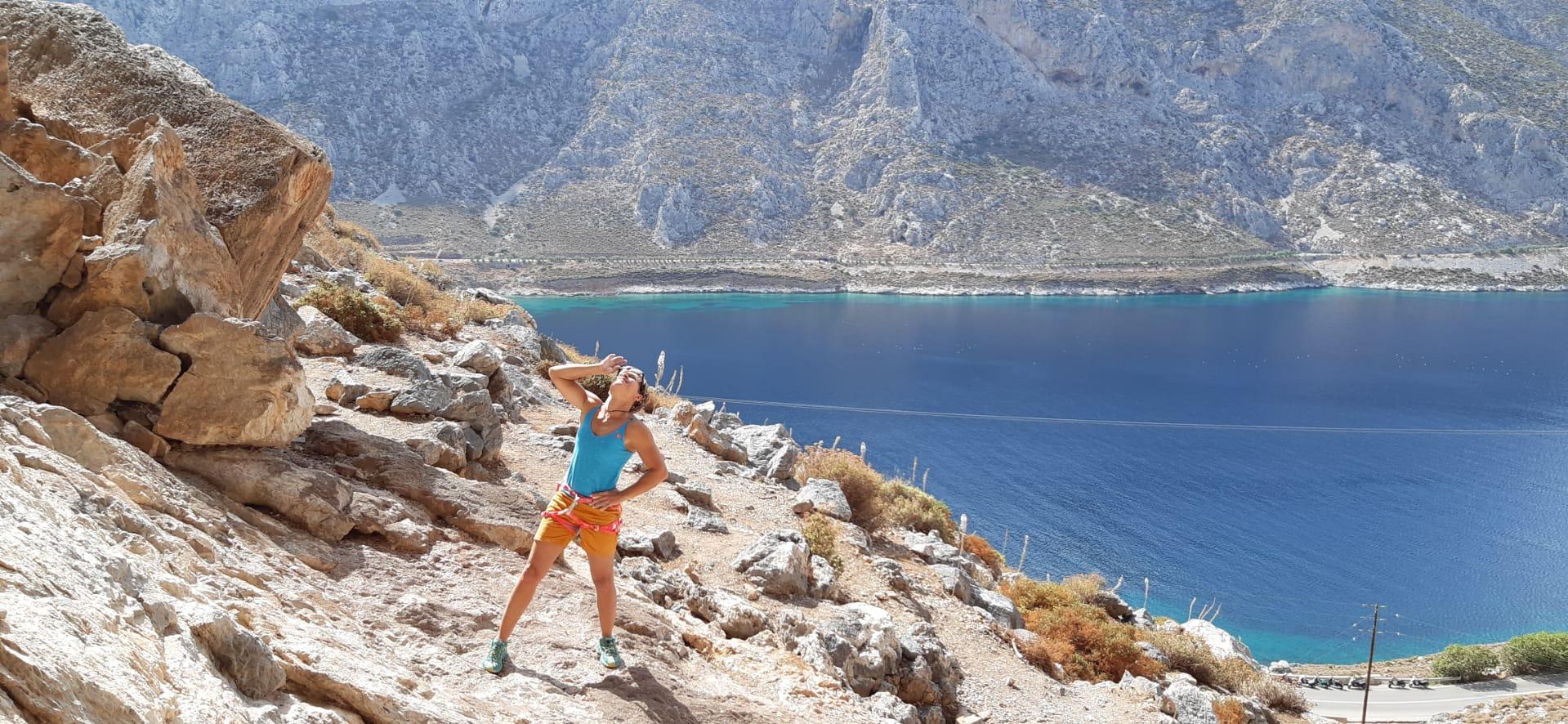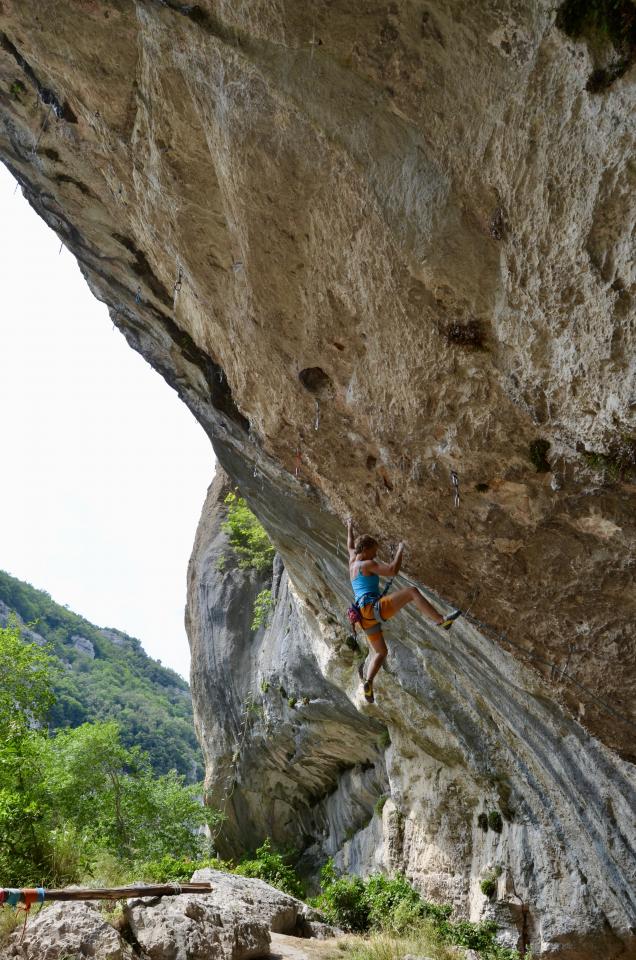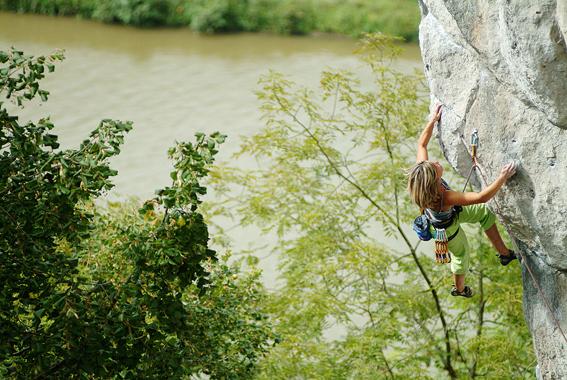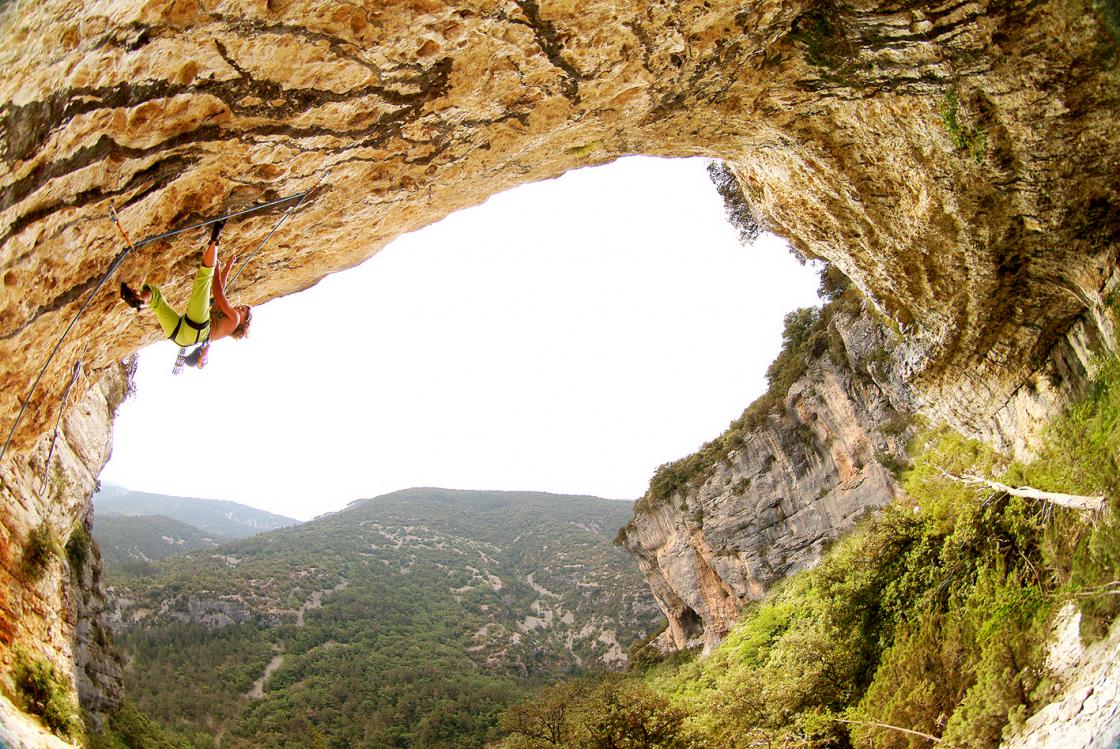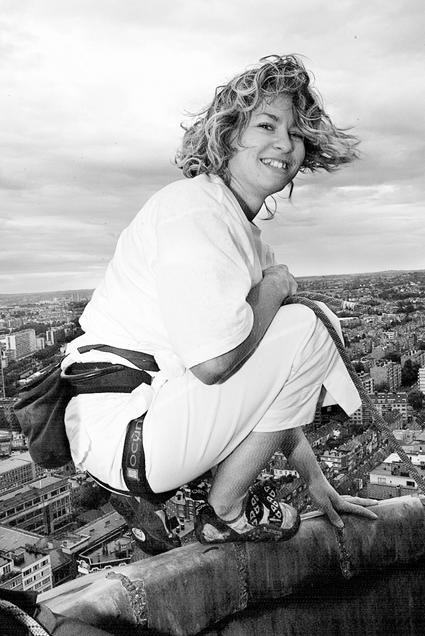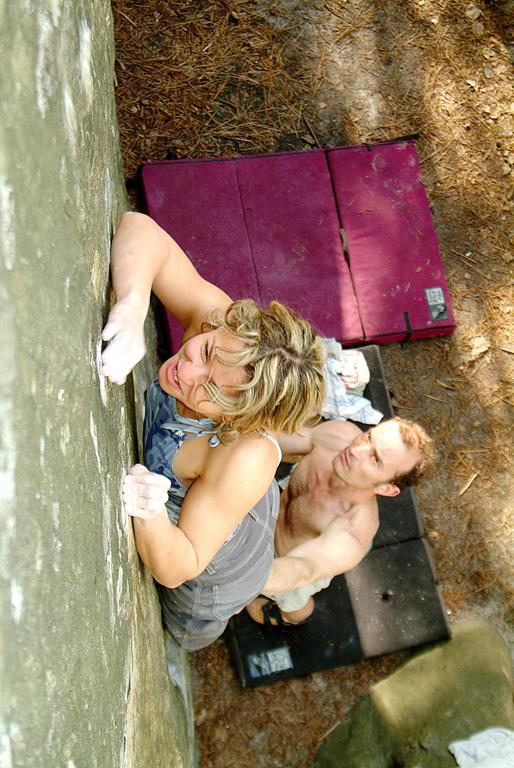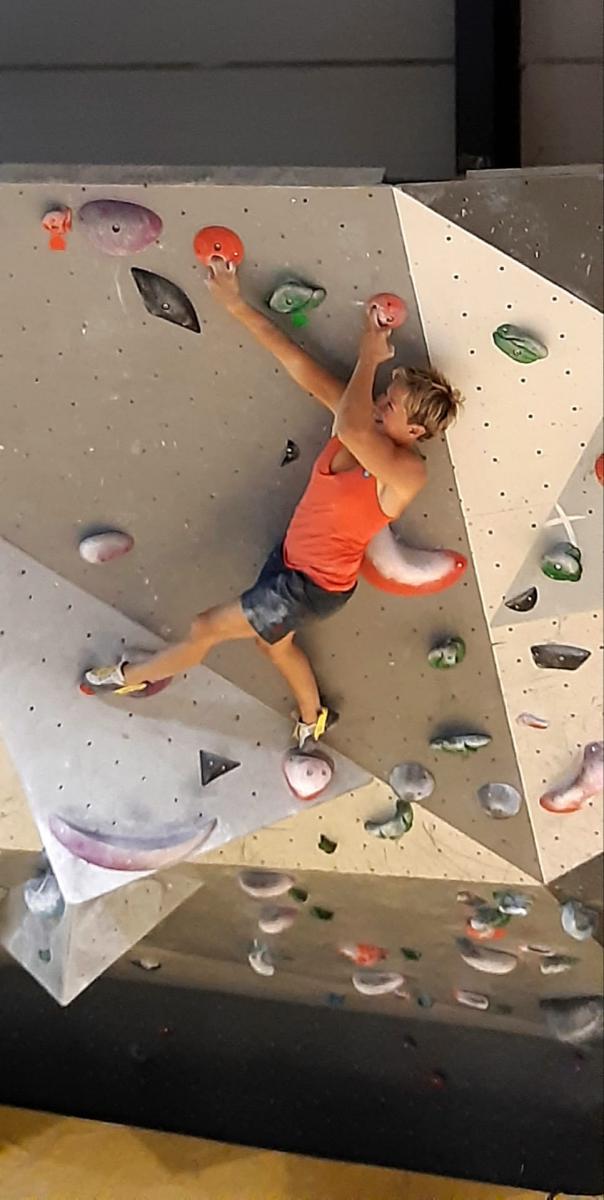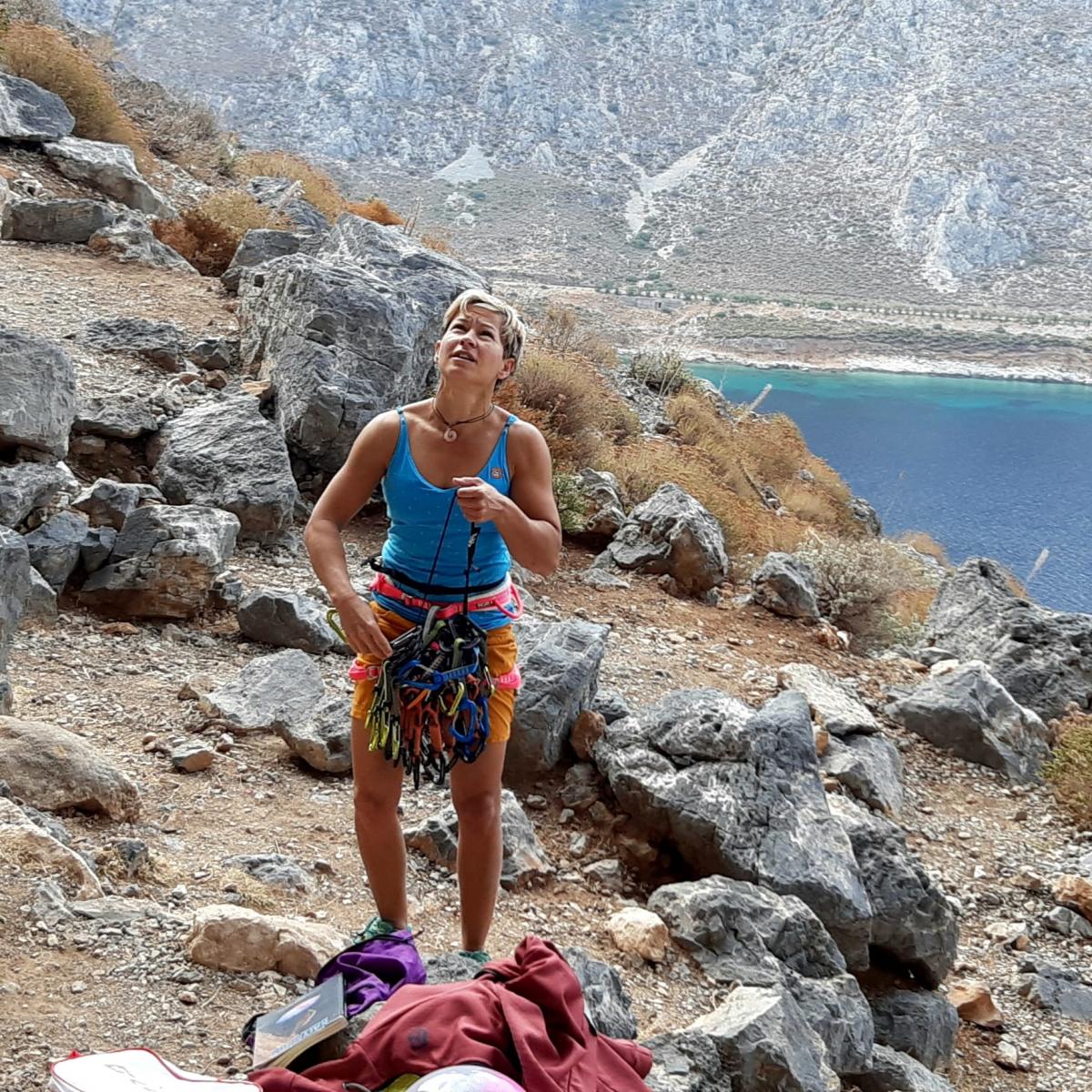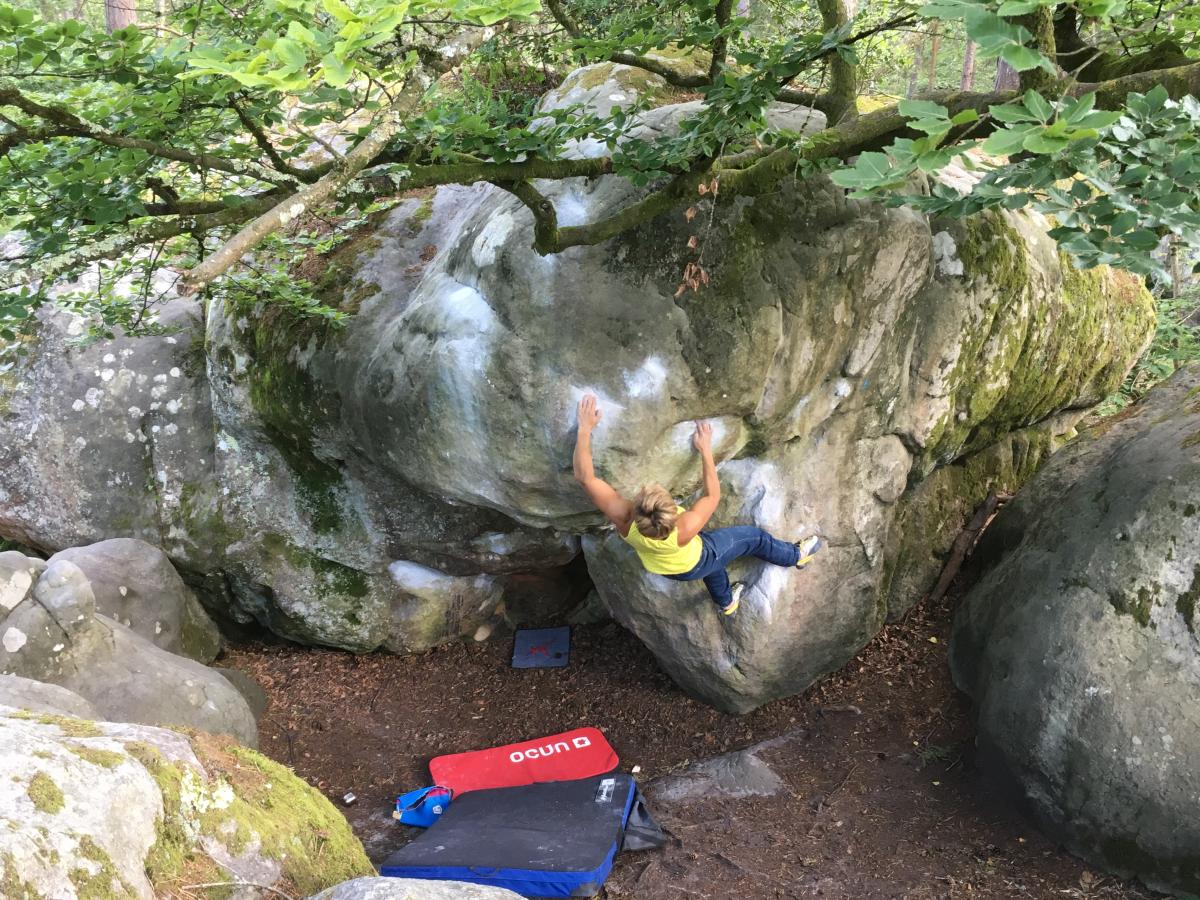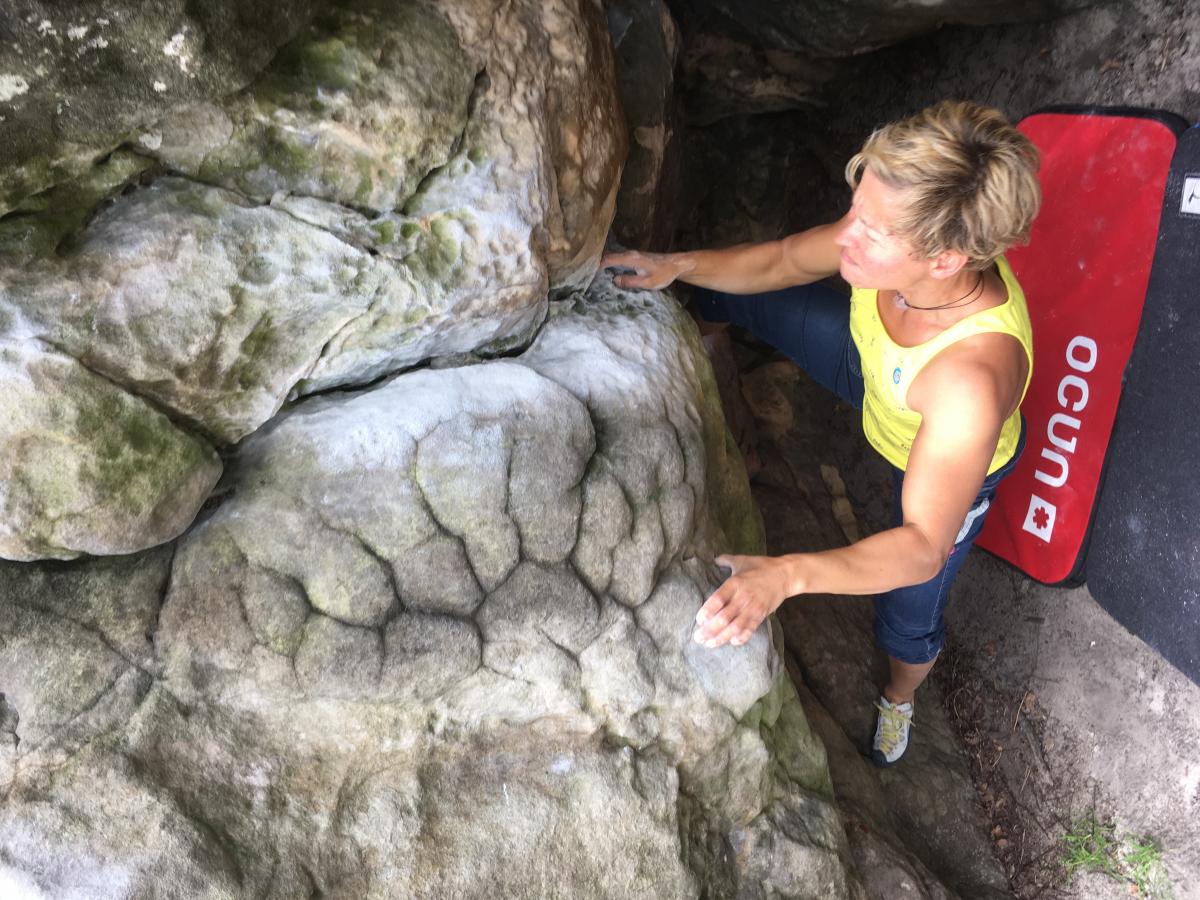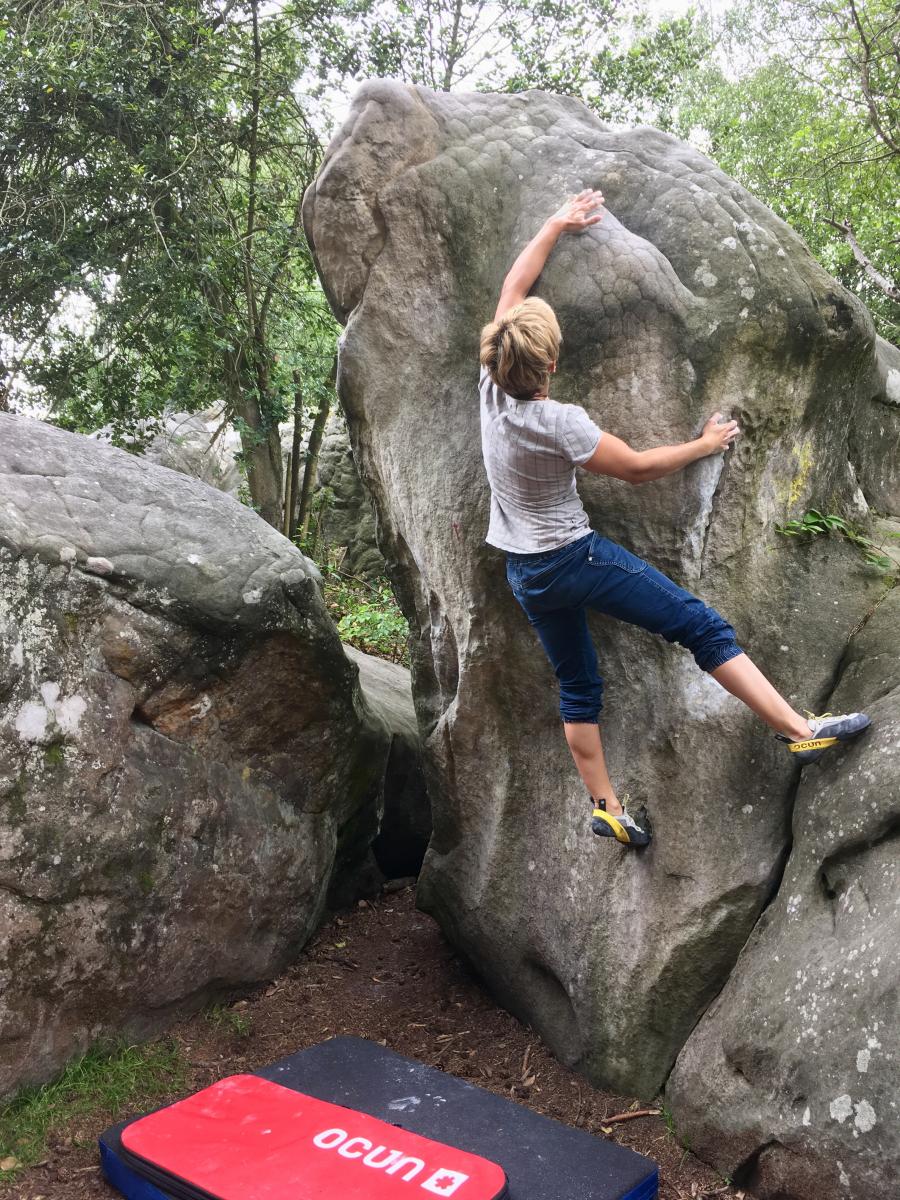Who is Muriel Sarkany
Muriel Sarkany (45) is from Belgium. She started climbing at the age of 16, focusing on competitive climbing at first. She won the lead World Cup five times – which makes her the most successful woman in competitive climbing so far – and became World Champion in 2003 after being the vicechampion three times.
She quit competing in 2010 and 3 years later she climbed Punt-X 9a in Gorges du Loup, becoming the fourth woman to send a route of this difficulty. She sent another 9a in 2017 – it was Era Vella in Margalef.
Life and climbing
The list of your achievements in climbing is impressively long. When did you feel the best, the strongest? Was it when you were winning the world cups, or when you sent your hardest routes?
I loved every of my hard sends outdoor, but the feelings there are very different from winning a competition. The feeling of victory is stronger because of all the stress that you went through. You´ve trained for this event and you know that you only have one chance. A little mistake and it´s over, even if you´re strong. The mental part is huge, you have to concentrate and overcome the pressure.
Winning a competition and especially becoming a world champion is a unique experience. You have the crowd behind you, the music, the speaker. When you win, you can hear the crowd so happy, cheering for you. The atmosphere is amazing, you feel like the Queen of the world.
When you send your project on the rock, you are often alone or with few people. If you fall, it’s only sad for the on-sight but you can try again. You are only climbing for yourself, always trying to push your limits but only for the pleasure of it, there´s no stress. But yeah, when you climb the route, you feel happy and proud of yourself. And it’s also mentally hard to continue over and over when it´s not happening. Finding solutions and never giving up.
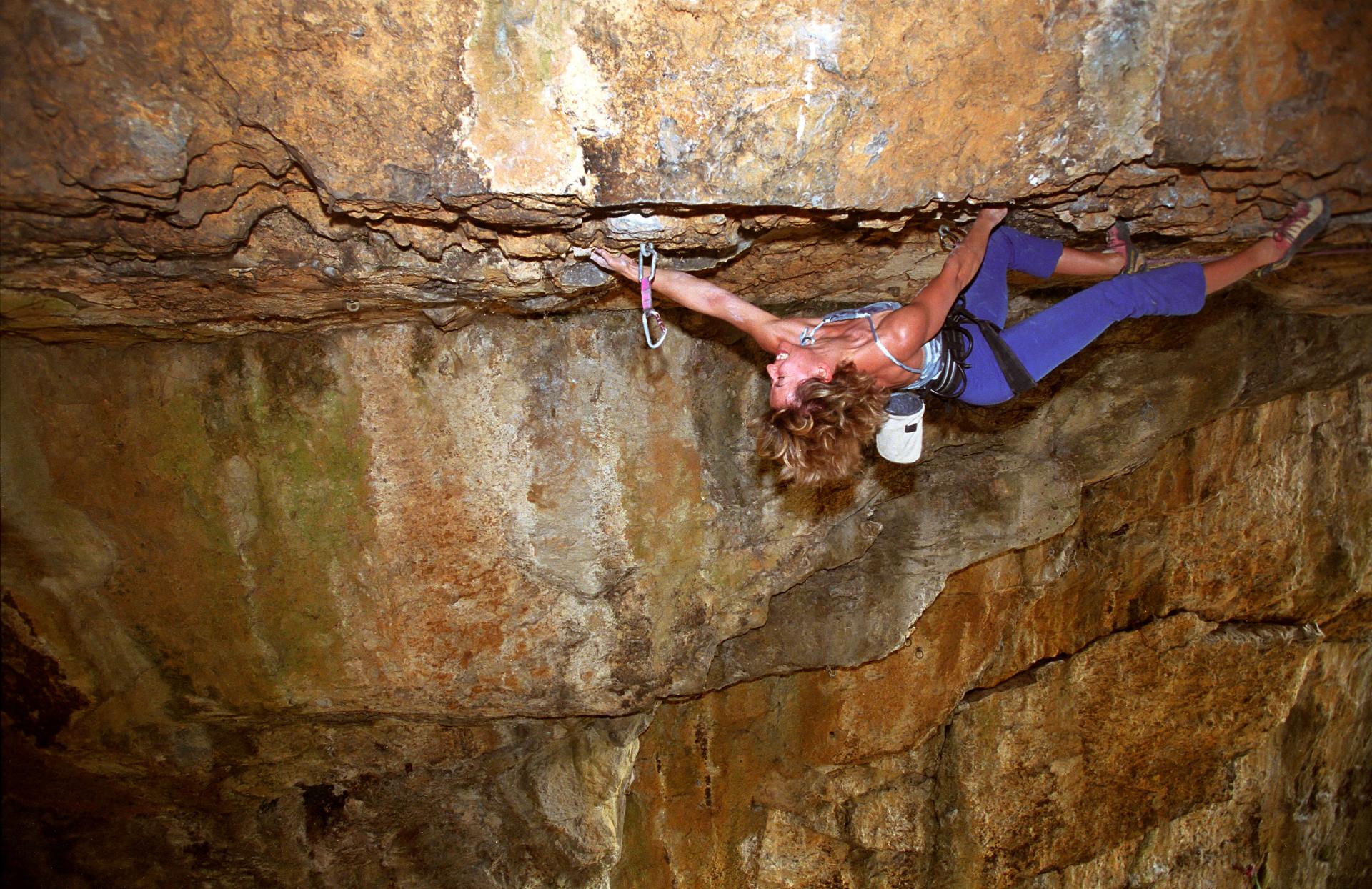
How was the second 9a different from the first one?
These two routes have nothing in common, they´re so different.
Punt-X , the first one in Gorges du Loup, is around 20 meters long, very steep, small holds, bouldery. The second one, Era Vella in Margalef, is a very long route, 50 meters, more about endurance, a mega strength effort with a boulder section in the middle of the route.
Fo me there was one more difference – I climbed the first one before being 40 and the second one after turning 40.
I really like to try different style of routes, it’s a challenge for me and I love challenge.
How do you choose your projects?
It depends. I love to travel around the world and discover new places. Before going to a new crag, I look at the guide book and make an idea of which route I want to try and I often change my mind when I see the rock. I never look at climbing videos before going in a route. It´d take the pleasure of discovery away. Plus I never do the same moves as other climbers anyway.
I always begin by choosing the most beautiful lines, the ones I want to climb whatever the grade and then I try the others. And of course, if I succeed a route, I always want to try harder and harder.
In case of some projects, like Era Vella, I saw pictures in the magasines and I couldn’t stop thinking of it. It became an obsession how much I wanted to try it. When I saw the line and the surrounding landscape and when I tried the route for the first time, I knew that it´d become my project. In a way, I was sad to send it and stop going there, because Era Vella is so beautiful. I think that I will come back at some point just for training and the pleasure of making the moves.
How do you manage to stay in shape?
I love climbing, it’s probably the secret. I love training, I need to train and if I don’t climb or train for 2 or 3 days I feel the defficiency. I’m not always in a 9a shape, but when I’m having a project, I can get in shape really fast. Specifically for the route by trying the moves and fighting in it.
I’m training since I was 17 and I think that I have developped a good method for staying in shape without injuries. My biggest strength, I think, is my mental setup, both in training and in the routes.
In my climbing life, I only had 3 littles injuries, never serious. I always listen to my body and when I feel something isn´t right, I stop, I rest a little more and if it’s not better, I work on my weakness.
Would you say that you had to sacrifice something to climbing in your life?
I’m very lucky, I never had to sacrifice anything. When I was young, my parents supported me in my dream of choosing sport as “job” and luckily I quickly succeed to prove them they where right to believe in me.
I could live with my passion for all these years of competitions. It was a dreamy life. After competitions, I found a job in the climbing world. It’s not as easy to train but I can still find time to go rockclimbing.
In my personal life, I have the huge luck to be with someone who supports me in all my dreams and goals.
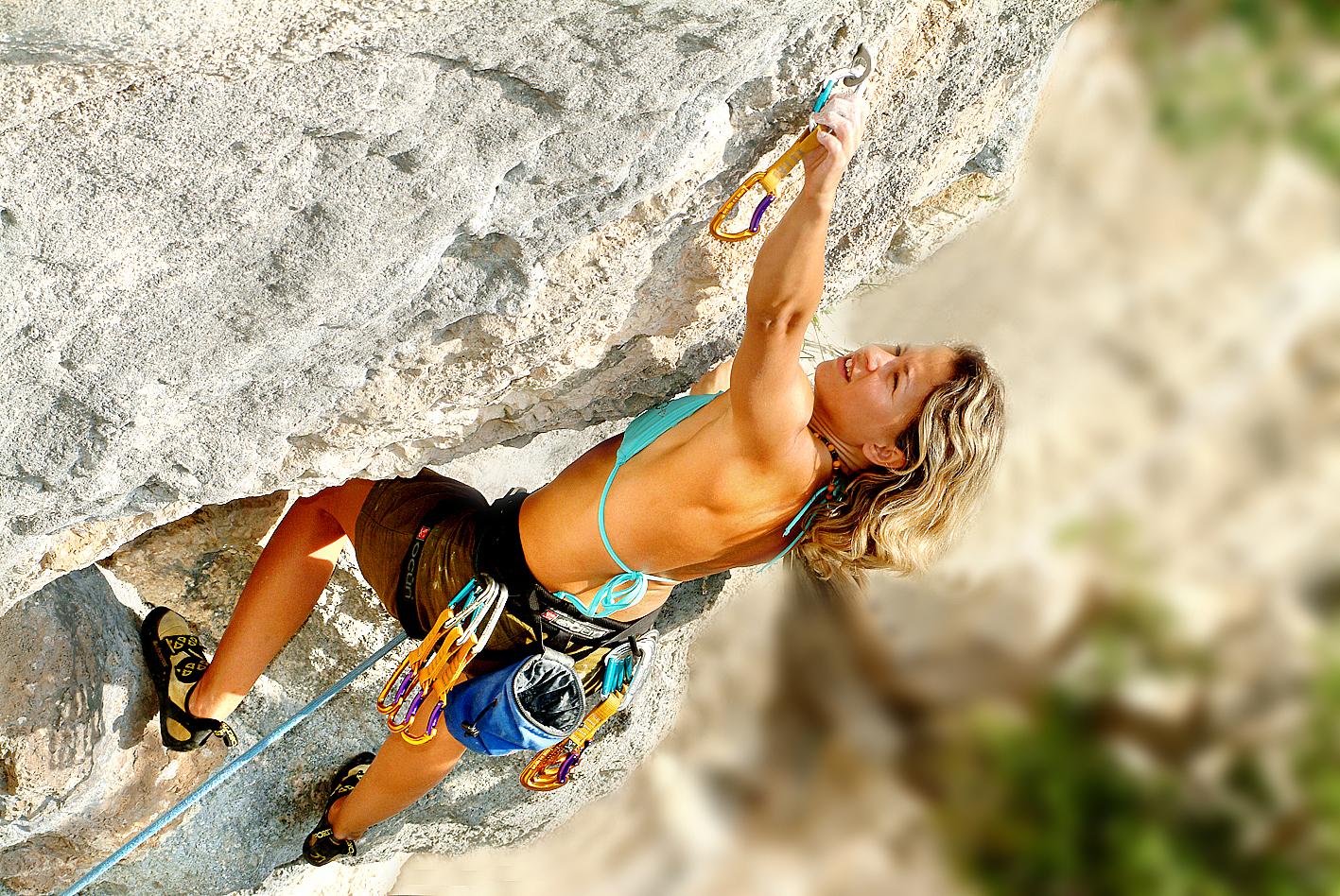
About body proportions
You are a small girl. Do you ever complain about not reaching a hold? Do you see it as a handicap, or not?
I’ve tried many different routes in many crags and sometimes I had to give up because I couldn’t reach the holds. At the competitions it was very frustrating to fail in a move not hard, just reachy. In outdoor climbing, I can often find a different way by holding very small holds in between the main ones or by doing a risky jump.
When I’m climbing a route, I don’t care if some moves are too long. If it’s hard, but possible, I just need to train harder, be stronger and be clever enough to find a different solution. Eventually I will do it. Sometimes an 8a is harder for me than an 8b but then when I make it I’m proud of myself and it’s a valuable send for me. That’s the most important thing because at the end that’s all that matters, you are just climbing for yourself, to make yourself happy.
It’s tougher when I try something hard and then somebody of average height makes a go and pass the move without any trouble or finds a kneebar that I’m too small to use. Then the tall guy comes down and downgrades the route. In such moments it´s crucial to focus on the route and on the pleasure of climbing. I´m also teling myself in such situations that it’s a good training for the next project. But sometimes I have to give up a climb simply because I feel that I could risk an injury by trying it. But it’s not that sad, there´s so many routes in the world.
Finally, Punt-X, my first 9a, wasn’t that hard for me because there are no morpho moves. There are no rests for anybody, so it´s probably the same grade for everybody. And I’m used to do harder moves in routes than others – so for once it was my advantage.
Do you think that a shorter climber must be way stronger to climb the same grades as a climber who is tall?
Yes, sure! I have to compensate my small size with strength.
What´s your ape index?
I don’t know, I never checked it. But let’s check now. It might help people see how small I really am. So body height: 153 cm, arms span: 150 cm. Which means ape idex 0,98 or -3 cm.
About climbing outdoors
What´s your style? How would you describe an ideal hard route for you?
I think that my favorite style is a long steep route with pockets or pinches.
What´s your antistyle?
Probably slabs, because they´re often very reachy. And I prefer when it’s more physical.
Do you often seek your antistyle to fight your weaknesses?
No, but if I see a great line, I will try the route whatever the profile. If the route is nice, I will be trying it until I succeed. Then I work on my weakness without really seeking it.
Is there any route that keeps shutting you down? Are you planning to continue?
There are some routes that I’ve tried and that I haven’t had enough time to send or that I’ve tried in bad conditions (too cold, wet, too warm). There are also routes in which I was blocked because of a very long move or routes where reaching the next hold required a solution which was way too hard. Their grade would have been so much higher for me than the real one. Or sometimes I felt that I could get hurt. But even despite that they stay in a little place in my head. I know that I will probably go back there one day to try them again. I like to think that I can climb everything, I just need to come back stronger. But meanwhile I simply found other nice routes to climb. I have some of these hard “projects” left in Santa Linya and Oliana.
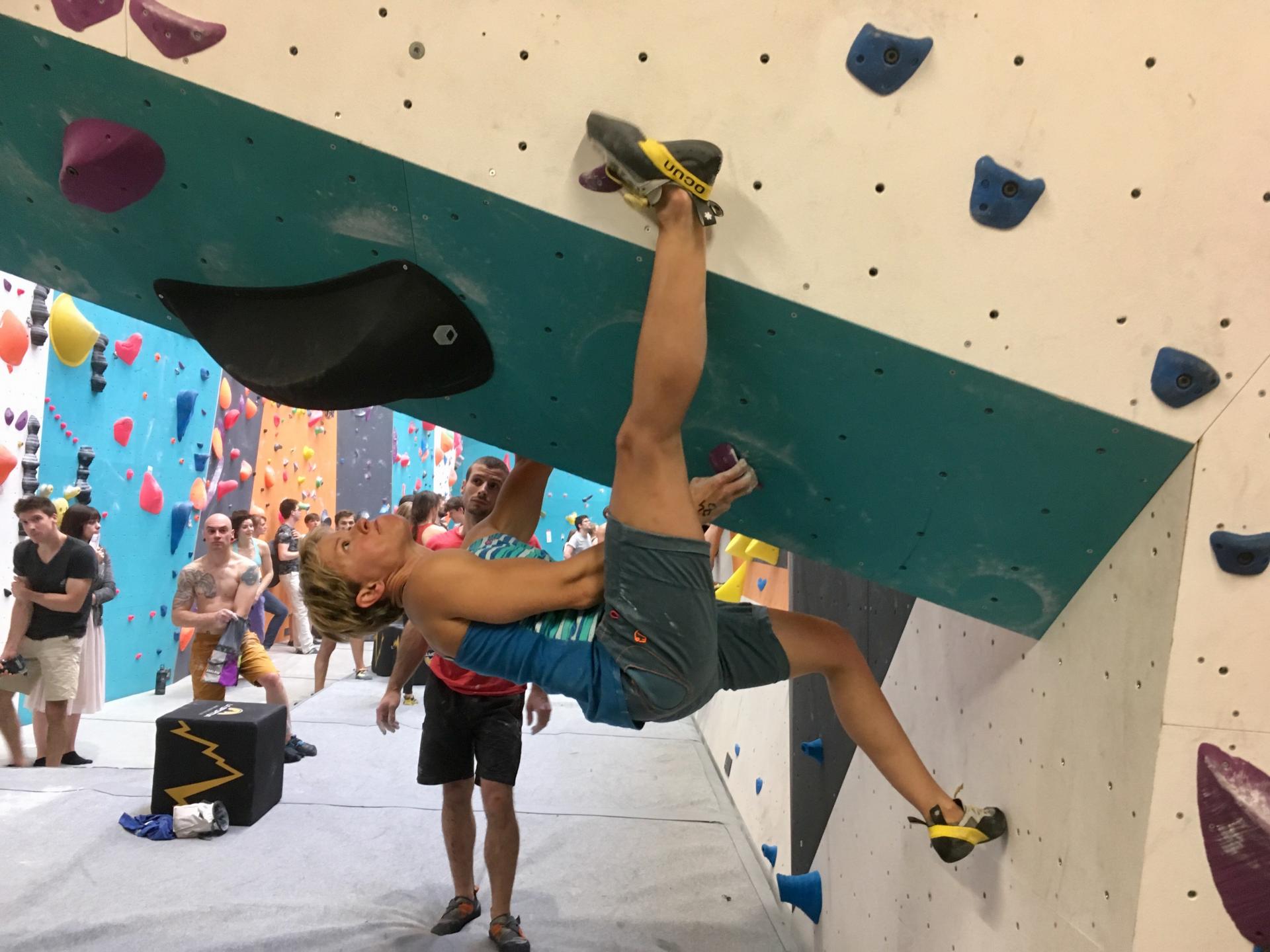
About competitions
What did you like about competing? What did you not like about it?
The competitions make us push our limits real hard and allow us also to compare with the best climbers in the world. I’ve always loved training and I wanted to be a professional athlete. Competitions were the only way there for me as a climber from Belgium.
The strength of a competitor is a mix of being a good climber and having an exceptional mental strength. Because strong climbers don’t neccessarily succeed at the competitions due the pressure.
What I didn’t like was the fact that there are no other holds or footholds in between for the smallest climbers – like it is in the crags. I also didn’t like the change of the rules caused by the effort to get climbing to the Olympic games – climbing time is shorter, so routes are shorter, plus they must be more visualy impressive which leads to including more jumps for the sake of television. It´s all getting more bouldery with flat holds and lesser footholds. In total it was really not for me.
I´m wondering – maybe if the competitions didn´t change so much, I´d probably still be competing.
Nowadays, competitive climbers barely climb outdoors. The pressure is hard on them, especially because of the upcoming Olympics. How much did you manage to climb outdoors back at the time of your competitive career?
I wasn’t climbing much outdoor. The competition season lasted from April to November with competition twice a month all over the world, plus the Masters. So it wasn´t easy to find time for climbing outdoors. Once you go climbing outdoors, you never stop and that´s how you can get an injury. It’s hard but you don’t have a choice. It’s also way more difficult to earn money by only rock climbing, so if you want to be a professionnel climber, you need to compete win. And for that you need to train a lot inside.
I took a few weeks every year to have some fun outdoor, no hard projects, just pleasure. It was OK. Some people can do both maybe, but I need to focus on my goals, if I want to succeed. I took them seriously and it worked.
Now I think that I´ve already made up for the lost time outdoors. Life is made of choices and concessions. So make choices, work hard for what you really want and never regret. It’s my philosophy.
What do you think of the Olympic combination?
I find it to be a bad idea to combine the three disciplines and to train for them like an IronMan. Our sport is climbing and not triathlon. Plenty of athletes were not very happy about it and I understand them. Training for lead and bouldering may be combined, but speed is a totally different effort.
I no longer feel that concerned. I’m not competing anymore, but I still think it’s a mistake not to have the three disciplines at the Olympics individually. This is how we realise that the IOC has no idea what climbing is. The Olympic medalists will not be a fine representation of the world’s best climbers.
What was the main reason for you to quit competing and start climbing outdoors?
After 19 years of competing I wanted to change my lifestyle. Competing is a special life because everything you do is tightly connected to the next goal, the next competition. My life was spinning around the next world Cup or World Championship. Even though I loved competitions, it was a very stressful lifetime for me.
In the meantime the IFSC changed the rules which lead to the change of the style of the routes. The IFSC shortened the climbing time. The routes became shorter and more dynamic moves occured. As you can imagine, huge moves are not my favourite due to my body heigth. If I wanted to follow this style, I would have had to change the way I train. But I don’t really like this kind of risky compressing moves. They don´t resemble outdoor climbing that much any more.
So I decided to stop and to finally spend all my climbing time on the rock. Just pleasure, no more pressure. It was the right time.
About training
How did you change your approach to training throughout your life?
I didn’t change it a lot. I think that I know what I need and I do it. There are no secrets. If you want to be stronger, you need to train progressively and listen to your body. Don’t try to do moves that you see in videos, if you are not used to them. And always warm up.
Personally, I never do campus board. I tried but it’s not good for my elbows, so I train without it. It´s about finding out what’s good for you.
Throughout years, I added a lot of general body workout – very useful for small climbers, by the way – and more stretching.
Do you train specifically for your goals, for the routes you chosen?
No. When I have a project, I simply get in shape for the route by trying it.
Do you keep any specific diet?
No, I never kept any diet in my life. My advantage is that I don’t like alcohol so I don’t drink beer, despite being a Belgian. I know it’s rare. On the other hand I must set the limits on my consumption of chocolate and nutella.
